John Hurrell – 17 April, 2017
Dwyer is restlessly innovative in his exploration, particularly when layering and exploiting the transparent resin and the thin, see-through, enamel layers on top of it, or the beautifully grained surfaces of slabs of cherrywood or ash that project at right-angles out from the wall, butted next to the hollow blocks of dense glowing colour.
Nineteen new small works are presented here by Johl Dwyer, an artist who is now a regular exhibitor at Tim Melville. Varied in nature, some are projecting wall relief sculptures (with thick layers of decoratively grainy wood) that clearly are extensions of his painting, while others continue his salient interest in flat cedar stretchers, oil absorbent plaster, clear stabilising resin, gold leaf borders and layers of brightly coloured enamel that has been repeatedly sanded, relayered, buffed and polished.
Dwyer is normally known for his interest in wooden stretchers - eschewing canvas or wooden panels - and how traces of oil in the cedar can result in smoky stains in plaster if the unset liquid is poured around and into the restraining frame. However there are very few plaster works in this show, though there are two or three that have had resiny blobs poured onto plaster bases, and which have been painted with dark grey oil paint before being then ground down.
Most of the show uses highly saturated enamel painted on to hollow cube or rectangle-shaped, plywood wall reliefs; or poured translucent resin in the flat works where enamel is then added in repeated layers on the other side.
Dwyer is restlessly innovative in his exploration, particularly when layering and exploiting the transparent resin and the thin, see-through enamel layers on top of it, or the beautifully grained surfaces of slabs of cherrywood or ash that project at right-angles out from the wall, butted next to the hollow blocks of dense glowing colour.
With the resin and enamel works, the resin liquid is poured into the cedar stretchers from the back when the wooden rectangles are lying flat, face down on glass covered with Tyvec. The matte resin fills in the central core of the stretcher and then - after it has hardened - Dwyer flips it over and from the front begins layering, sanding, relayering and buffing. The final stage involves polishing with a sheepskin the glossy enamel that strangely stays translucent in itself. Occasionally he paints a dark colour across the inside so that a dark rectangle, not the white gallery wall, is detectable.
Looking at densely reflective, opaque, enamel colour on a three dimensional cube, butted next to a grainy wooden slab, and looking through layered enamel and resin in a flat painting are of course, very different. Chromatic optical qualities rely on their support material and its overall shape and surface textures. These are obviously crucial; the angle to the light, reflection, transparency and refraction all play a role. The colour doesn’t hover in the air in resplendent isolation; you can’t ponder it as a disembodied essence without an attendant substance, texture or ground.
Some reliefs obviously allude to Donald Judd, especially the horizontal ones with walnut slices flush with the wall, and painted hollow plywood boxes extending out between upper and lower cedar ‘slabs’ that are unpainted, but Dwyer is very different. He likes the contrast between the outer organic wood patterns and the intense monochrome blocks sandwiched in between, or alongside - with their fruity lollylike pastel colours. They have an exuberant Poppy quality, and sometimes hint of dessert food products (like ice cream, mousse or blancmange) and amused gustatory consumerism.
The reflective flat paintings on the other hand, while sometimes shiny like lacquered car bonnet surfaces, are also slightly ominous in their pool-like murkiness and use of mysterious optical depth. As smooth handmade objects they reject suggestions of bland industrial finish or sterile impeccability, for manual traces are nevertheless still evident and deliberate - all the while subtly delighting in the metaphor of deep translucence, and underneath, investigatory ocular substance.
John Hurrell












 Advertising in this column
Advertising in this column Two Rooms presents a program of residencies and projects
Two Rooms presents a program of residencies and projects



This Discussion has 0 comments.
Comment
Participate
Register to Participate.
Sign in
Sign in to an existing account.